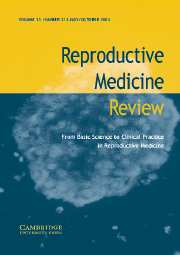Article contents
The causes and management of endometrial breakthrough bleeding
Published online by Cambridge University Press: 14 February 2002
Abstract
The term breakthrough bleeding (BTB) is rather poorly defined, but essentially describes the symptom of vaginal bleeding occurring with scheduled periods of withdrawal bleeding, in the absence of pelvic pathology in women taking exogenous sex steroids, usually contraceptives or hormone-replacement therapy (HRT). It may also describe occasional bleeding in those who are predominantly experiencing amenorrhoea due to these preparations. Rather confusingly, the term is sometimes used to describe intermenstrual bleeding in women who are not taking sex steroids, when structural or other pathological causes are more likely. In the absence of such pathology intermenstrual bleeding in the normal menstrual cycle is relatively uncommon, suggesting that exogenous sex steroids can profoundly disrupt the tight regulation of endometrial vascular development, function and breakdown. Intermenstrual bleeding also occurs spontaneously in some women and it is possible that this phenomenon has similar mechanisms to that seen in sex-steroid-related breakthrough bleeding.
- Type
- Research Article
- Information
- Copyright
- © 2001 Cambridge University Press
- 3
- Cited by


